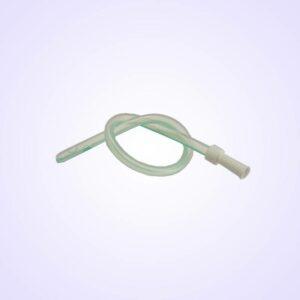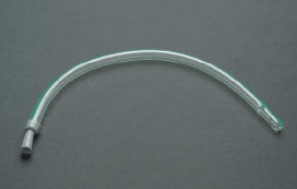Rectal tubes is a crucial medical devices, which plays a vital role in relieving a range of conditions like constipation, fecal incontinence, and pain. Whether you’re a healthcare professional or a patient, gaining a comprehensive understanding of the benefits and applications of rectal tubes is paramount for achieving optimal treatment outcomes. To ensure the safety and effectiveness of treatment, this blog will delve into the various types of rectal tubes, their advantages, and the correct insertion techniques. Additionally, we will explore the merits of both single-use and reusable rectal tubes, along with specialized pediatric rectal tubes designed explicitly for children.
But first, let’s talk about Medzell, a futuristic B2B platform that aims to promote Indian medical devices in emerging markets. Medzell offers a wide range of medical equipment, including needles, at competitive prices.
Types of Rectal Tubes
- Single-Use Rectal Tubes: These are rectal tubes intended for one-time use. After use, they are disposed of, reducing the risk of cross-contamination and infection transmission.
- Reusable Rectal Tubes: These are rectal tubes designed to be sterilized and used multiple times. They are made from materials that can withstand sterilization processes without compromising their integrity.
- Pediatric Rectal Tubes: Pediatric rectal tubes are specially designed for use in children. They are sized and shaped to be more comfortable and safe for pediatric patients, considering their anatomical differences.
Each type of rectal tube serves a specific purpose and caters to different patient populations or medical requirements. Medical professionals should choose the appropriate type of rectal tube based on the patient’s age, medical condition, and the intended use of the tube.
Why Single-Use Rectal Tubes Are Safer and Hygienic
Single-use rectal tubes are specifically designed for one-time use, offering significant advantages in terms of safety and hygiene.
- Infection Prevention: Single-use rectal tubes greatly reduce the risk of cross-contamination and healthcare-associated infections. Using a new tube for each patient eliminates the possibility of transmitting pathogens from one individual to another. This becomes particularly crucial in healthcare settings where maintaining strict infection control measures is of paramount importance, including hospitals, clinics, and long-term care facilities.
- Elimination of Contamination: Single-use rectal tubes come in sterile packaging, ensuring that each device is free from contaminants. Unlike reusable tubes that require thorough cleaning and sterilization, single-use tubes eliminate the need for such processes, minimizing the chances of residual bacteria or other microorganisms.
- Convenience and Time Efficiency: With single-use rectal tubes, healthcare professionals can save valuable time that would otherwise be spent on cleaning and sterilizing reusable tubes. This allows for smoother workflow management and enables healthcare providers to focus more on patient care and other essential tasks.
- Patient Safety: Single-use rectal tubes prioritize patient safety by eliminating the potential for device-related infections. Patients can have peace of mind knowing that they are being treated with a new, sterile rectal tube designed specifically for their use, minimizing the risk of complications or adverse events.
- Cost Considerations: While single-use rectal tubes may have a higher upfront cost compared to reusable tubes, they can potentially save costs in the long run. By eliminating the need for cleaning, sterilization, and maintenance associated with reusable tubes, healthcare facilities can reduce expenses related to labor, equipment, and supplies.
It is important to note that single-use rectal tubes should be disposed of properly after use, following the waste management guidelines and protocols established by healthcare facilities and regulatory agencies. This ensures both environmental safety and adherence to proper disposal practices.
Optimize Cost-Efficiency with Reusable Rectal Tubes
While single-use rectal tubes excel in terms of safety and hygiene, reusable rectal tubes offer long-term cost advantages for healthcare facilities and patients. Consider the following benefits of reusable rectal tubes.
- Environmental Considerations: Reusable rectal tubes contribute to environmental sustainability by reducing the amount of medical waste generated. With proper cleaning and sterilization, these tubes can be used for an extended period, minimizing the disposal of single-use items.
- Durability and Longevity: Reusable rectal tubes are typically made of durable materials, designed to withstand repeated use and sterilization processes. With proper care and maintenance, these tubes can have a longer lifespan, ensuring reliability and performance over an extended period.
- Effective Cleaning and Sterilization: Proper cleaning and sterilization protocols are crucial for ensuring the safety and effectiveness of reusable rectal tubes. Healthcare facilities should follow strict guidelines for cleaning, disinfection, and sterilization to maintain the integrity of the tubes and prevent the transmission of infections.
- Compatibility and Customization: Reusable rectal tubes offer the advantage of compatibility with various medical procedures and patient requirements. They can be available in different sizes and designs to accommodate diverse patient populations, ensuring optimal fit and comfort during use.
To maximize the cost-efficiency of reusable rectal tubes, healthcare facilities should establish effective protocols for cleaning, disinfection, and sterilization. These protocols should align with industry standards and guidelines to ensure proper decontamination and minimize the risk of infection transmission.
It is important to note that while reusable rectal tubes can provide cost advantages, their use requires a comprehensive approach to ensure proper cleaning, sterilization, and maintenance. Healthcare professionals should receive adequate training on cleaning protocols, and the facility should have appropriate resources and infrastructure for effective reprocessing of reusable rectal tubes.
Pediatric Rectal Tubes for Safe and Gentle Relief
Pediatric rectal tubes are specifically designed to provide safe and gentle relief for children who require rectal procedures or treatments. Here are some key points highlighting the benefits of using pediatric rectal tubes.
- Child-Friendly Design: Pediatric rectal tubes are crafted with a child’s anatomy and comfort in mind. They are smaller in size compared to adult rectal tubes, ensuring a better fit and minimizing discomfort during insertion and use.
- Gentle and Effective Relief: Pediatric rectal tubes offer a gentle and non-invasive approach to provide relief for various conditions, such as constipation, fecal impaction, or the administration of medications. They can stimulate bowel movements and facilitate the evacuation of stool without causing undue discomfort to the child.
- Safety Features: Pediatric rectal tubes often come with safety features to ensure proper usage and minimize the risk of injury. These features can include rounded tips, smooth edges, and soft materials to prevent any harm or irritation to the delicate rectal tissue of children.
- Age-Specific Options: There is a range of pediatric rectal tubes available, catering to different age groups and sizes of children. This ensures that healthcare professionals can select the most appropriate tube for each child, considering their age, weight, and specific medical needs.
- Medical Procedure Support: Pediatric rectal tubes can be used for a variety of medical procedures, including the administration of medications, contrast agents, or the collection of stool samples. They provide a convenient and safe means of delivering treatments or obtaining diagnostic samples from young patients.
It is important for healthcare professionals to receive proper training on the correct usage and insertion techniques of pediatric rectal tubes. They should also ensure that parents or caregivers are involved in the process, providing consent and understanding the procedure’s benefits and potential side effects.
Discovering Relief: How Rectal Tubes Alleviate Pain in the Body
Rectal tubes are not only used for medical procedures but also for pain management in various conditions. Let’s explore how rectal tubes can provide effective relief from pain and discomfort.
- Targeted Pain Relief: Rectal tubes are designed to deliver medications directly to the rectal area, allowing for targeted pain relief. This route of administration can be especially beneficial for conditions such as hemorrhoids, menstrual cramps, or prostate inflammation, where localized relief is desired.
- Alleviating Muscle Spasms: Rectal tubes can help alleviate pain caused by muscle spasms in the rectal or pelvic region. By delivering muscle relaxants or analgesic medications directly to the affected area, they can help relax the muscles, reduce spasms, and provide relief from associated pain.
- Increased Absorption: The rectal route of drug administration offers advantages in terms of increased drug absorption compared to oral medications. The rectal mucosa has a rich blood supply, allowing for efficient absorption of medications into the bloodstream, leading to faster pain relief.
- Non-Invasive Approach: Rectal tubes provide a non-invasive method of delivering pain relief. This can be particularly beneficial for individuals who may have difficulty swallowing oral medications or those who prefer to avoid injections or other invasive procedures.
- Patient Comfort: Rectal tubes are designed to be comfortable during use, minimizing any discomfort or pain associated with their insertion and presence. Smooth, rounded tips and appropriate lubrication can enhance patient comfort during the procedure.
Healthcare professionals should closely monitor patients during treatment and adjust the therapy as necessary. Rectal tubes offer a valuable option for pain management, allowing for targeted delivery of medications to provide relief from various conditions. When used appropriately and under professional guidance, rectal tubes can significantly improve the quality of life for individuals experiencing pain or discomfort.
How to Properly Insert a Rectal Tube for Safe and Effective Treatment
Here you will find step-by-step instructions for inserting a rectal tube safely and effectively. We’ll also discuss the potential risks and complications of improper insertion and how to prevent them.
Before starting the procedure, it is important to explain the purpose and process to the patient or caregiver and obtain informed consent. The patient should be in a comfortable position, such as lying on their side with their knees bent and their buttocks slightly elevated.
Next, prepare the necessary equipment, including a lubricant, gloves, and the rectal tube. The size of the tube should be appropriate for the patient’s age and size. It is also important to ensure that the tube is not damaged or has any sharp edges.
After donning gloves, apply a generous amount of lubricant to the tip of the tube. Gently insert the tube into the rectum, being careful not to force it and using a twisting motion if necessary. If resistance is encountered, stop and reposition the tube or try a smaller size.
Once the tube is inserted, secure it in place using adhesive tape or a specialized holder to prevent accidental displacement. The tube should be positioned to allow for drainage or administration of medication, depending on the purpose of the procedure.
During the procedure, monitor the patient for any signs of discomfort, bleeding, or infection. Follow standard infection prevention and control measures, such as hand hygiene and using sterile equipment.
After the procedure, remove the tube slowly and gently, and dispose of it appropriately. Provide the patient with aftercare instructions, such as maintaining good hygiene and monitoring for any complications.
Proper technique and preparation are essential for safely and effectively inserting a rectal tube. Following the steps outlined above can help ensure a successful outcome and minimize the risk of complications.
Rectal Tubes from Leading Indian Manufacturers
Rectal Tubes
Angiplast Pvt. Ltd., one of the leading rectal tube producers in India, offers a top-quality medical device at a reasonable price. The Rectal Tube is designed to provide effective and comfortable rectal treatments, ensuring patient safety and satisfaction.
Made from medical-grade PVC, the Rectal Tube by Angiplast Pvt. Ltd. features a soft, translucent, and clear tube. Its high-quality construction meets stringent medical standards, ensuring reliability and performance.
Equipped with a radio-opaque line throughout its length, this rectal tube allows healthcare professionals to easily monitor its position using imaging techniques. This ensures accurate placement and effective treatment outcomes.
The surface of the Rectal Tube is siliconized, facilitating smooth and easy insertion. Patients experience minimal discomfort during the procedure, thanks to the tube’s atraumatic design. The soft rounded closed tip reduces tissue injury, providing a gentle and safe treatment experience.
Rectal Tubes
Alpha Medicare and Devices Ltd., a renowned medical device manufacturer in India, presents the Rectal Tube, a reliable and effective solution for rectal treatments. This high-quality device is designed to provide optimal performance and patient comfort.
The Rectal Tube by Alpha Medicare and Devices Ltd. features a smooth ivory finish that is non-toxic and non-irritating, ensuring the safety of patients during procedures. The tube is thoughtfully designed with a broad lateral eye and rounded tip, preventing any obstruction caused by focused matter. This ensures consistent and efficient fluid flow during treatments.
To facilitate accurate positioning and monitoring, the Rectal Tube includes a radio-opaque line. This line enhances visibility under X-ray, enabling healthcare professionals to precisely track the tube’s placement and make necessary adjustments as required.
The large lateral eye and rounded tip of the Rectal Tube further contribute to its effectiveness. By preventing occlusion by focal matter, the tube ensures smooth and unobstructed flow, optimizing the treatment process and patient comfort.
Conclusion
Rectal tubes are a vital medical device used in a variety of clinical settings. From pain relief to fecal incontinence treatment, these devices offer a safe and effective way to improve patient outcomes.
Whether you choose single-use or reusable rectal tubes, it’s important to use them correctly and in accordance with best practices. By following the proper insertion techniques and ensuring the device is properly sterilized, you can minimize the risk of infection and promote better patient outcomes.




